Muay Thai [มวยไทย] or Thai boxing is the national martial arts of the Thai people. The origin of muay Thai dates back to ancient times. Muay Thai tactics utilizes all parts of the body, namely fists, legs, elbows, and knees. Despite its deadly reputation, the spirit of muay Thai is characterized by discipline and respect. Today, muay Thai is recognized not only as an international sport and important aspect of Thai culture and heritage, but also a community rooted in self-improvement and the Thai value of respect.
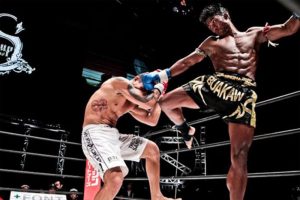
[Post Today]
History
Southeast Asia is home to many fighting styles that emphasize the use of several body parts, from fists and feet to knees and elbows, to deliver strike attacks. Many today refer to these fighting styles as “boxing”, though their origins and traditions are distinct from Western boxing. Southeast Asian “boxing” styles can be found in Cambodia, Laos, Malaysia, Myanmar, and Thailand. Each variation, while sharing many similarities, also possess their own unique histories and charms.
Muay Thai, like many other styles of Southeast Asian “boxing”, originated as a form of bare hand combat that utilizes all parts of the body. This form of fighting is called muay [มวย] in the Thai language and was utilized by ancient communities to defend against attacks. Thus, “muay Thai” in the early sense can refer to different types of muay practiced by the Thai people. Each region developed their own techniques of fighting, leading to the formation of systematized combat styles. These fighting styles are known today under the umbrella term of “muay boran” [มวยโบราณ] or “muay Thai boran” which means “ancient Thai boxing”. Skilled fighters were revered as protectors of communities and caretakers of combat knowledge. Muay also served as a form of entertainment in local festivities, especially fairs held on temple grounds. Fighters fought in open space, using punctured coconut shell slowly submerged in water to mark the time of each round. Later, fighters would construct a form of combat gloves by wrapping tough strands of rope around their fist. This practice is known as kard cheuk [คาดเชือก] or rope wrapping and has led to muay boran also being referred to as muay kard chuek [มวยคาดเชือก].
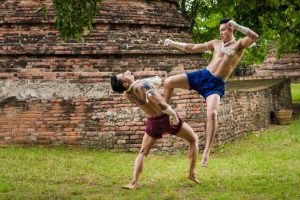
[tiewpakklang.com]
The four major schools of muay boran which influenced the development of modern muay Thai includes muay korat, muay lopburi, muay chaiya, and muay tha sao.
- Muay korat [มวยโคราช]: Originating in the area of present-day Korat Province, muay korat is known for its powerful kicks and punches. Fighters utilize wide-swing attacks for mid-range combat, but will switch to direct blows when engaging opponents up close. The most famous technique of this style is mat wiang kwai or the buffalo hurling fist, which is so powerful it could figuratively topple a buffalo.
- Muay lopburi [มวยลพบุรี]: Originating in the area of the present-day Lopburi Province, muay lopburi is known for its precision. Fighters confuse opponents by remaining in perpetual motion, before striking well-calculated blows. The most famous technique of this style is phra kan perd lok or Lord Reaper unveiling the world, which utilizes upward-facing fists to deliver punches.
- Muay chaiya [มวยไชยา]: Originating in the town of Chaiya in the present-day Surat Thani Province, muay chaiya is known for its form. Fighters utilize specialized postures and motions to advance towards opponents, before dealing out locks, knocks, and throws. The most famous technique of this style is a special form of footwork known as yang sam kum or three realms steps.
- Muay tha sao [มวยท่าเสา]: Originating in the area of the present-day Uttaradit Province, muay tha sao is known for its wide-ranging kicks. Fighters struck down opponents fast by focusing attacks on crucial points of the body. The most famous technique of this style is tai mek or cloud-climbing, which utilizes slow advancements towards opponents.
During the time of the Ayutthaya Kingdom (1350-1767 AD), muay was practiced by kings and commoners alike. Royals and noblemen kept an entourage of fighters to act as personal guards. These guards had the opportunity to be promoted to higher positions in the government if they demonstrated honor and great service to the state. This meant that muay was a way for individuals to advance themselves in society. Thus, muay training became highly selective, with only a few honorable individuals ascending to the rank of masters.
Many famous fighters were born during the Ayutthaya period. One such example is King Sanphet VIII who was also known as the Tiger King. According to legend, the Tiger King would test his fighting skills by disguising himself as a commoner to enroll in local boxing matches. If a worthy opponent is encountered, the king would make him his personal guard. The Tiger King also made a great contribution to the fighting arts when he wrote a manual on muay, which became the basis for mae mai [แม่ไม้] or main techniques in muay Thai today. Another famous fighter from the Ayutthaya period is Nai Kanom Tom, who was said to have been captured by Burmese forces after the fall of Ayutthaya. After beating Burmese fighters in a contest, Nai Kanom Tom was granted independence by King Hsinbyushin of Ava and was allowed to return home.

Statue of Nai Kanom Tom [Postjung:ฐรินดา]
After the fall of Ayutthaya, muay played an important role in the founding and defense of the Thonburi, and later, the Rattanakosin Kingdoms. King Taksin the Great of Thonburi fought alongside many great warriors, including Nai Thongdee Fun Khao (Thongdee the White-teethed) who was trained in the tha sao school. Legend hold that Thongdee fought with two swords in his hand. During an exceptionally strenuous battle, one of Thongdee’s swords broke off, yet, Thongdee persisted on and emerged victorious, earning him the noble title of Phraya Pichai Daap Hak or Lord Pichai of the Broken Sword. .
Muay reached a golden age during the reign of King Chulalongkorn the Great (Rama V), who arranged matches between famed fighter from across the kingdom. The winners were rewarded with money and titles. One of the king’s son, Prince Abhakara Kiartivongse, Prince of Chumphon, was highly skilled in the arts and went on to train many fighting masters. During the reign of King Vajiravudh (Rama VI), a stadium was setup at the Suankularb Wittayalai School, with muay becoming part of the curriculum. During this age, rules were formalized and the practice of kard chuek replaced with the use of western-style boxing gloves. With standardization of tournament formats and regulations, muay transitioned from the period of ancient muay Thai boran to the age of modern muay Thai as a formalized sport of the Thai people.
The first national muay Thai stadium, the Ratchadamnoen Stadium, was established in the year 1945 under the initiative of then Prime Minister Plaek Phibunsongkhram. Another permanent stadium, the Lumbhini Stadium was established in the year 1965. It was at Lumbhini Stadium that muay Thai matches were first televised and gained the attention of foreigners, with Thai boxers fighting alongside foreign contestants in the ring.
Art of Eight Limbs
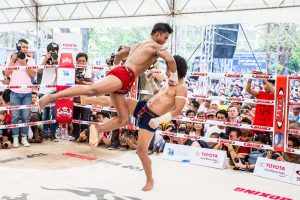
[Tourism Authority of Thailand]
Muay Thai is considered by many to be one of the most effective striking martial arts in the world. Muay Thai utilizes all parts of the body, especially the fists, elbows, knees, and legs. This maximal weaponization of the human body has led many to name the martial art “Art of the Eight Limbs”. Major attack forms can be divided into:
- Chok [ชก] or punches, which utilizes direct and wide-swing blows from the fists
- Sok [ศอก] or elbow, which utilizes a variety of elbow strikes
- Teh [เตะ] or kicking, which utilizes attacks from the legs. Muay thai fighters are oftenconsidered to be one of the best kickers in the world.
- Khao [เข่า] or knee, which utilized knee strikes
- Theep [ถีบ] or thrusting, which utilizes thrusting attack from the foot
Other than these forms of attacks include clinches, locks, and throws.
Training
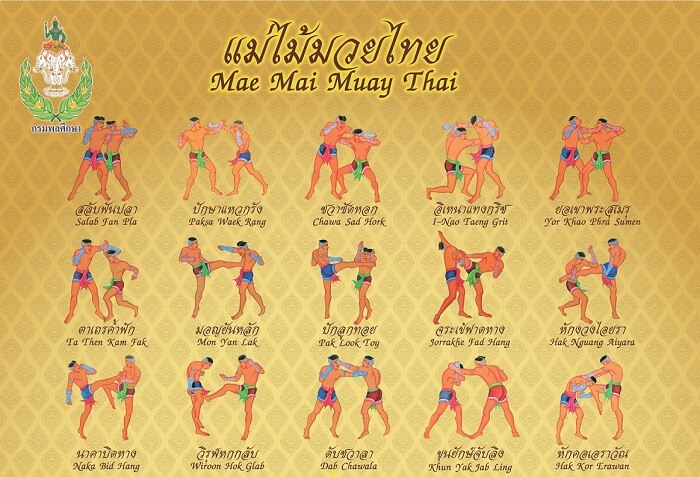
[Department of Physical Education]
The heart of muay Thai lies not in violence, but in the values of respect, restraint, and discipline. Traditional training begins with the conditioning of the body. The master guides the disciples through exercises meant to strengthen the muscles and bones as well as develop reflexes and balance needed for fighting. Ancient conditioning techniques involve practices such as repeatedly kicking banana stalks or balancing water jugs on a carrying pole, while modern techniques incorporate techniques such as weight-training. The students are also taught the value of discipline, which is necessary for developing the students into strong, honorable individuals capable of protecting their loved ones. It is during the conditioning stage that the masters begin to assess the characters of the students. In order to prevent the lethal art from falling into evil hands, the master must ensure that students are taught the value respect. Namely, the students must demonstrate respect towards their own teachers, family, peers, and even foes. The students must also demonstrate restraint from using their skills boastfully or in acts of blinded fury. Only students who have demonstrated physical readiness and all proper characteristics are allowed to progress to the next stage: combat training.
Traditionally, combat training begins with the training of mae mai [แม่ไม้] or basic techniques. There is a total of 15 mae mais as outlined by the manual of the Tiger King. Each lineage, however, may possess its own additional movements. The mae mai are designed to form the basis of attacks, blocks, evasions, and counterattacks. Once the students have mastered the mae mai, the masters will instruct them in look mai [ลูกไม้] or minor techniques. In modern times, combat training entails a mixture of traditional mae mai, look mai, and the techniques that the masters have proven to be useful in the boxing ring.
The result of the trainings is the transformation of the students from ordinary human beings into strong, disciplined, and respected members of society. In the past, this entailed the transformation of ordinary citizens into honorable warriors and protectors of the realm. The process of learning, however, does not stop at the trainings. It is only through further practice and fighting experiences that muay Thai practitioners develop their own techniques and insights. It could be said that the art of muay Thai is a never-ending process of learning, one that has been developing since the birth of the Thai civilization.
A few fighters who have demonstrated exceptional skills and qualities as well as having gained the respect of others are selected to become masters. Once selected, the old master will confer upon the new master all of the secret techniques as well as the right to pass on the art to new generations of fighters.
Traditions
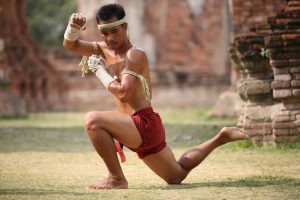
[Tourism Authority of Thailand]
One of the most recognizable features of muay Thai is the wai khru [ไหว้ครู] ritual dance, which is performed at the beginning of fights. Before performing the dance, fighters will circle the ring in a counter-clockwise direction, stopping to bow three times at the four corners in respect to the Buddha, dharma (teachings of the Buddha), and the sangha (monastic disciples of the Buddha). The fighters then commence the wai khru dance by kneeling to bow in respect for their masters, parents, and other spiritual forces that they worship. After that, the fighters perform specific movements that demonstrate strength and beauty. Each lineage of muay Thai possesses its own set of wai khru movements that are passed down from teachers to disciples. Other than the demonstration of respect, the wai khru dance also serves as a form of warmup and a way for fighters to identify their lineages.
During the wai khru dance, fighters wear a sacred headgear called mongkhon [มงคล]. The mongkhon is placed upon the head of the fighter by his/her masters, often accompanied by incantations. As reminiscent of muay Thai’s kard chuek (rope-wrapping) origins, the mongkhon is usually constructed out of ropes, cloths, or other similar materials. It is not uncommon for the materials used in the construction mongkhons to possess esoteric qualities, such as burial shrouds or robe fragments of revered monks. Another gadget that is sometimes worn during wai khru dance is a pair of armband called prajiad [ประเจียด]. Like the mongkhon, prajiads are often constructed out of occult-significant materials.
Wai khru dance and boxing matches are accompanied by a type of musical ensemble known as pi klong [ปี่กลอง]. This type of ensemble is composed of an oboe called pi chawa [ปี่ชวา] or Javanese oboe, a pair of drums called klong khaek [กลองแขก], and a cymbal known as ching [ฉิ่ง]. The pi klong ensemble is also used for other societal functions, such as funerals and royal processions; however, the music for each occasion remains quite distinct from each other. The melody for wai khru dance is known as Yone Plaeng [โยนแปลง] and is characterized by a solemn, fearsome tune. The melodies used during the fights, on the other hand, are more joyful and arousing.
International Recognition
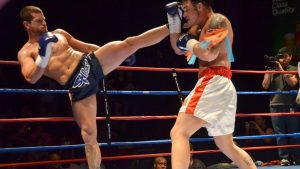
[my-kohphangan.com]
Today, muay Thai is regarded as one of the most effective forms of striking martial arts. Many techniques of the Art of Eight Limbs have been adopted by the discipline of mixed marital arts (MMA). With the rise of Thai tourism, muay Thai has also gained international popularity. Numbers of foreign fighters have increased dramatically over the years, with gyms being erected all over the world. Many foreign fighters travel to Thailand to train and compete in matches. The Thai government holds an annual World Wai Kru Muay Thai Ceremony at the ancient capital of Ayutthaya.
The martial art has also proven to be popular among fitness enthusiasts. Muay Thai trainings offer a non-mundane, full body experience of exercise, which benefits muscle strength, cardio health, and mobility. The spirit of self-discipline and respect functions as a major attracting point for all practitioners, fighters and exercisers alike.
Outside the realm of sports and fitness, muay Thai has garnered considerable attention in the entertainment industry. Films, videogames, comic books, and television series centered around martial arts often feature elements of muay Thai. Notable appearances include the film Kickboxer (1989), Tom-Yum-Goong (2005), and the character Sagat from the Street Fighter series, among others.
Sources
- Department of Cultural Promotion, Ministry of Culture
- Thailand Now: https://www.thailandnow.in.th/arts-culture/what-is-muay-thai-discover-the-art-of-eight-limbs/
- Department of Physical Education https://www.dpe.go.th/manual-files-392891791804
Written by: Tayud Mongkolrat


